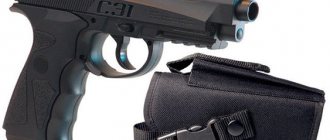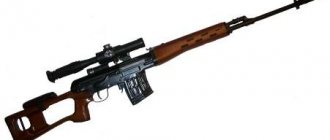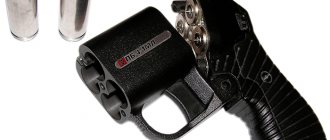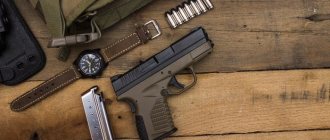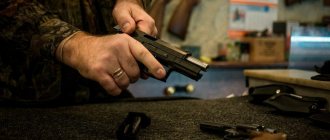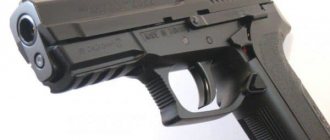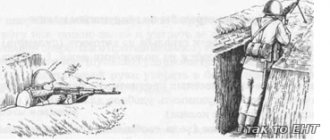In modern Russia, pneumatic and so-called traumatic weapons are the most accessible to respectable citizens , both from a financial and legal point of view. Moreover, pneumatics are often considered by buyers who are poorly versed in the topic as a budget means of self-defense.
In fact, the difference between “air guns” and “trauma guns” is not limited to price alone: there are many technical and legislative nuances that separate these two categories of weapons. Let's look at them in detail.
So which one should you choose?
Despite the cheapness and all the other advantages of pneumatic weapons, they are completely unsuitable for the needs of self-defense : they are not legally approved for this and are practically ineffective. It is worth purchasing an air gun only to practice your weapon handling skills.
much more preferable as a defensive weapon - but only at first glance. “Traumas,” which are legally almost equal to full-fledged military weapons, in reality have many limitations and disadvantages that make them unreliable and dangerous to use. Therefore, it is not possible to recommend the purchase of LLC to anyone.
MiscellaneousComment
Airguns
A pneumatic weapon is a weapon in which a projectile is fired under air, gas or steam pressure . Hand-held pneumatic weapons acquired their current form around the end of the century before last.
The range of pneumatics is very wide, and includes pistols, shotguns and rifles, and machine guns. The barrel can be either smooth or rifled; the most popular calibers are 4.5 mm and 5.5 mm . Smooth-bore samples use round steel bullets, while rifled ones use aerodynamically shaped lead bullets.
There are many circuit diagrams by which air guns can operate, but the most common are the following:
- Spring-piston - the shot is fired by air, pressure is created in the cylinder by a spring-loaded piston, which sets in motion when the trigger is pressed. The spring must be charged before each shot.
- With pumping - the shot is fired with air, previously manually pumped into the cylinder. Each press of the trigger opens the throttle, through which a portion of compressed air is released from the cylinder, sufficient to accelerate the bullet. The cylinder is enough for several shots, but without pumping up the power of each subsequent shot decreases.
- Gas-balloon - the shot is fired with carbon dioxide from a factory-made disposable can. Contrary to popular belief, the can contains not compressed gas, but liquid carbon dioxide, which evaporates at room temperature. The resulting gas, as in pumped weapons, is released in portions through a throttle connected to the trigger. At the same time, due to thermodynamic equilibrium, a constant pressure is maintained in the can, so the power of the shots is maintained at approximately the same level.
Russian Federal Law No. 150-FZ “On Weapons” provides for the possibility of using pneumatics for sports and entertainment purposes and hunting. According to general requirements, pneumatic weapons must not allow firing in bursts and have a magazine with a capacity of no more than 10 bullets. It is further divided into 3 categories:
- T.N. “products structurally similar to weapons” with muzzle energy up to 3 J inclusive - can be purchased without a license, registration or other restrictions.
- Samples with a muzzle energy of no more than 7.5 J and a caliber of no more than 4.5 mm are purchased without a license by citizens over the age of 18.
- Models with a muzzle energy of 7.5-25 J and/or a caliber of more than 4.5 mm are purchased under a license and require registration.
Possession of pneumatic guns with a muzzle energy of more than 25 J is prohibited by law. It is prohibited to carry systems of the 2nd and 3rd categories in a charged or equipped state and to use them outside special shooting ranges.
Thus, you can always have with you in a combat-ready state only a gas-cylinder pistol with a muzzle energy of up to 3 J, which is quite convenient and is de jure not considered a weapon.
conclusions
So, what is the difference between pneumatic and traumatic? To use trauma equipment you need a license, but for pneumatics it is not required. The next difference is the material from which the bullets are made: for traumatic guns it is rubber, for pneumatics it is metal. The use of trauma can cause the death of a person. It costs more than air guns. Air rifles are commonly used for hunting and training.
The problem of how to choose the right most powerful traumatic pistol (or OOPP) often faces people who care about self-defense issues.
At the same time, power is often not the most important selection factor. It is also necessary to consider:
- the presence of a trigger spoke, which reduces the ability to quickly remove;
- size;
- ease of pulling the shutter, which can be a problem for people who are not very physically strong (a revolver is more suitable for them);
- the ability to use both rubber and gas charges, which makes it convenient for a variety of situations;
- store volume;
- reliability and probability of misfires;
- finally, prices, which can fluctuate quite a lot.
In Russia, it is permissible to use a weapon whose muzzle energy does not exceed 85 J. The standard cartridge size is 9 mm.
When choosing, you must also take into account the reasons why it is purchased - for sports shooting and for hidden carrying for work (security guards, etc.) purposes or for self-defense purposes - different things.
This review will look at the most popular models that fire rubber and gas bullets.
Traumatic weapon
A firearm that is not intended to kill is called traumatic . Traumatic pistols appeared in the 1980-1990s. and have become widespread in those countries where citizens are prohibited from having short-barreled firearms for self-defense, including Russia.
Modern Russian legislation defines “injuries” as “firearms of limited destruction” (LOD). In fact, it is divided into 3 categories:
- Gas pistols and revolvers with the ability to fire rubber bullets.
- Pistols and revolvers for firing plastic bullets.
- Barrelless shooting devices.
An unobvious difference between categories 1 and 2 is power : gas pistols are less durable and less suitable for firing bullets, so they use cartridges with a reduced powder charge.
By law, traumatic weapons use special cartridges that differ from combat sizes, and have limiters in the barrel that do not allow firing solid projectiles. The magazine capacity cannot exceed 10 shots , and the muzzle energy for civilian models is 91 J. Self-loading pistols are prohibited from being carried with a cartridge in the chamber.
All traumatic weapons are purchased under a license and registered, and citizens who have not served in the Armed Forces can buy a “trauma” only at the age of 21 . You can own a maximum of two LLC units.
What is more powerful? Trauma or pneumatics?
The power of the devices is determined by the muzzle energy of the propellant element. The greater its mass and initial speed, the higher the J value.
Traumatic weapons win, but you need to take into account that the air guns are sold weakened. After modification of the pneumatic, the power can exceed the 25 Joules permitted by the Law on Weapons. These models are dangerous, especially the 6.35mm PCP rifles, due to their stopping power. In terms of the latter parameter, the rubber arrow is ahead of compressed air devices, but is considered conditionally dangerous.
Pneumatics and traumatology: differences and similarities
The only similarity between pneumatics and traumatic guns is that both of these options are not considered military weapons.
What is the difference between pneumatic and traumatic? To wear a traumatika, registration and a license are required. No documents are required for pneumatics.
Rubber bullets are used for traumatic weapons; iron or aluminum balls are used for pneumatic weapons.
Exposure to trauma causes significant harm to health, including death. Pneumatics do not cause much harm to humans.
In some cases, trauma is used by law enforcement officers. For example, to pacify and immobilize particularly violent lawbreakers.
Comparison
Trauma and pneumatic weapons are two completely different types of weapons. The only difference is that both are not combat weapons. So, here are the main differences between them:
- To use a traumatic pistol you must have a special permit. No such document is required for pneumatics.
- Traumatic weapons fire rubber bullets with a metal core, while air guns shoot iron or aluminum bullets.
- Traumatic weapons can cause serious harm to human health, including fatal injury. Pneumatic weapons practically cannot cause any harm to the human body. Very often, law enforcement officers carry traumatic weapons with them in order to pacify particularly hot-tempered citizens.
- The cost of a traumatic pistol is usually higher. Although some pneumatic models can reach prices of 2-3 thousand dollars. However, you can buy a cheaper option - for five to eight thousand rubles.
- Air guns are a training option that can be used both for hunting and for entertainment. Trauma is very close in spirit to military weapons.
Trauma
Traumatic pistols are much closer to the combat version of weapons, so special permission is required to carry them. In fact, traumatic weapons belong to the category of firearms, and the only difference is the characteristics of the bullet. In traumatism, lead bullets are used, and rubber bullets (with a metal core). This is done so that, if necessary, the bullet can be seen on an x-ray. The main purpose of the weapon is self-defense.
Traumatic pistol Stalker
Briefly about pneumatic weapons: types of pneumatics, what to choose
In this article we will talk about air guns , which are becoming increasingly popular.
Indeed, few people will refuse to purchase a good air rifle or pistol without the hassle of obtaining a license, which shoots far and accurately, and looks almost like a real weapon.
Although not everyone fully understands what shooting pneumatics are, why they are needed and what can be expected from them. In this regard, we decided to fill this gap.
The very first thing to remember is the important fact that pneumatics are divided into three very different categories based on the magnitude of the muzzle energy of the shot - up to 3, from 3 to 7 Joules, and above.
Air rifles and pistols that fire a bullet with an energy of less than 3 J are toys that you can shoot from, of course, not absolutely anywhere, but many places, as long as you don’t hit anyone or anything.
The next category of pneumatics is pistols and rifles with muzzle energy in the range from to 7.5 J.
This is already a weapon, albeit far from lethal, but it, like any other civilian weapon, is subject to all the requirements of the Weapons Law, and they are as follows: shoot only in specially designated places, that is, in shooting galleries and shooting ranges; transported in cases, unloaded; carrying such weapons in combat-ready condition is prohibited.
There are also pneumatics with a muzzle energy than 7.5 J. However, it already requires an acquisition license, the procedure for obtaining which is exactly the same as for firearms, and we will not consider it for now.
The principle of operation and design of pneumatic weapons
Now let's move on to the design of the shooting pneumatics. There are not so many principles on which it can work, or more precisely, there are only four of them.
Carbon dioxide air guns
Carbon dioxide pneumatics consume cans of liquid carbon dioxide, similar to those used in siphons for making carbonated drinks, however, unlike siphon cans, weapon cans do not contain 8 g.
carbon dioxide, and 12. These are almost all pneumatic copies of combat pistols, class up to 3 J.
More powerful weapons based on this principle are much less common and, as a rule, these are semi-sports pistols, and carbon dioxide rifles are even more rare.
Spring-piston pneumatics
The operating principle of this pneumatic weapon is a spring-piston design, in which a cocked spring pushes the piston inside the cylinder, thereby creating air pressure that acts on the bullet.
The vast majority of commercially available air rifles operate precisely on this principle.
At the same time, there are very few spring-piston pistols on the Russian market; as a rule, these are the domestic MP-53M pistol or the Spanish Gamo R-900.
PCP rifles and PCP pistols - pre-inflated
The principle of operation is the energy of compressed air, previously pumped into a tank built into the weapon. The pressure in the tank can reach up to 300 atmospheres, due to which the energy of the bullet can reach higher values than in other types of pneumatic weapons.
Such weapons are usually called PCP rifles and PCP pistols, using the English abbreviation PCP - Pre-Charged Pneumatics.
In most cases, it costs much more than pneumatics based on other principles, but it is the most powerful and accurate of all shooting pneumatics.
Compression and multi-compression pneumatics
In this case, the weapon has a built-in pump with a pumping lever, which the shooter must pump once or many times, then load the bullet and fire.
Such weapons are also quite poorly represented in Russia and the CIS; most often they are products of the American company Crosman; however, the domestic sports pistol MP-46M belongs to this category, but it is expensive and not very widespread.
Which air gun to choose?
To do this, you also need to understand the point that pneumatic weapons, like firearms, can be smooth-bore or rifled.
Carbon dioxide copies of combat pistols, as a rule, are equipped with a smooth barrel and fire steel balls, the diameter of which is slightly smaller than the caliber of the barrel, which means their shooting accuracy is not very high.
Moreover, such a weapon is compact and very effective - it easily breaks glass containers. If these qualities can be useful to you, then such a weapon is your choice.
If you need to shoot exactly at the bull's eye of the target, then you should choose a weapon with a rifled barrel that shoots lead bullets. These weapons also differ in accuracy classes, but even the worst examples will be much more accurate than pistols with a smooth barrel. This is usually enough for an ordinary shooter who does not claim sports records.
Spring-piston pneumatics are almost always less accurate than other systems, since the movement of the piston causes a double recoil phenomenon, in which the weapon first jerks forward and then back, which interferes with aiming the more powerful the weapon. That is, spring-piston weapons are either weak, but accurate, like the domestic MP-60 or 61 rifles; either average in power and quite heavy, or powerful and inaccurate.
Carbon dioxide pneumatics, in principle, do not provide much shot energy, and the speed of a bullet fired from it depends on the ambient temperature.
Multi-compression weapons have a very low rate of fire.
And only PCP rifles and PCP pistols are devoid of most of these shortcomings, which determines their high cost. However, even such pneumatic weapons have some problems associated with the need to refill with air compressed under high pressure.
In short, that's all we have. The final choice is yours.
Source: https://lastday.club/kratko-o-pnevmaticheskom-oruzhii-tipy-pnevmatiki-chto-vybrat/
What is the best air pistol for self-defense?
When choosing a pneumatic gun for self-defense, there are many different factors to consider. Of course, it is necessary to take into account the technical characteristics and quality of the material used to make the case. Products with a plastic exterior can also have high performance capabilities.
It is important to ensure that there are no plastic parts in the firing mechanism. Their presence can negatively affect the reliability of air guns.
An air pistol has fairly low power.
Light bullets used for shooting do not have high penetrating power and actually do not have a stopping effect on a potential enemy.
The killing ability of such projectiles will also be minimal, so a hit may be accompanied by the formation of small bleeding wounds and minimal pain.
The maximum possible power of a pneumatic weapon for self-defense, which is permitted by law, is kept at 7.5 J.
This power level is low enough to cause serious harm to human health. In this context, an air pistol will only be positioned as a psychological barrier for an attacking enemy. The power of the weapon is only enough to pierce the skin unprotected by clothing. Subsequently, a hematoma may form in this place.
Features of choosing bullets
To achieve maximum effect, the bullet must have high kinetic energy. Upon contact, it is transmitted to the body. The optimal bullet weight for an air pistol is 6-9 grams. In addition, the projectile must have a large cross-sectional area.
The bullet weight of the 9*18 PM cartridge is 6.1 grams. The initial speed of such a projectile when fired from the pneumatic version of the Makarov pistol is equivalent to 315 m/s. If a spherical version of the bullet is used, this figure drops to 110 m/s. When such a projectile enters the skin, it causes shallow wounds. Parts of the body covered by clothing will remain completely undamaged.
There is another type of bullet that has increased lethality. However, their use is restricted to law enforcement officials only.
In addition, such bullets significantly complicate the feeding of the cartridge and can lead to damage to the barrel.
To ensure the most reliable operation of the automation, it is most advisable to use projectiles with an ogive head.
Pistol reliability
The reliability of a pistol is determined not only by the proper operation of all mechanisms, but also by the quality of the body.
In most cases, the pneumatic variation of the weapon is made using a silumin alloy.
As a result, we can talk about the high resistance of the gun surface to negative corrosive influences. However, silumin alloy is brittle and cannot effectively withstand mechanical loads.
When choosing an air pistol for self-defense, you should also pay attention to the build quality. If it is low enough, the weapon may fail at the most necessary moment. For this reason, it is recommended to examine the gun very carefully when purchasing for the presence of cracks and gaps.
Similarity to its combat counterpart
An air pistol for self-defense has a general visual similarity to its military counterpart. For a person who has sufficient knowledge in this area, it will not be difficult to distinguish these two variations. However, in the evening it will be difficult to recognize an air pistol.
A professional can easily distinguish an air pistol by its small-caliber barrel, clamping screw, and also by the presence of a layer of paint on the body. Also, pneumatics can be given away by a cast bolt and the fact that there is no ejector. When the bolt is jerked, there is no characteristic sound accompanying the process of chambering a cartridge into the chamber.
Where to shoot?
Despite the fact that air guns do not have sufficient power, if used correctly, such a gun can be very effective during self-defense. First you need to decide where to shoot during the attack. This will depend on the number of attackers and the location of the conflict.
Considering the fact that pneumatic weapons can pierce the upper skin, it is most advisable to aim at exposed areas of the body. A shot in the face can dissuade the attacker, giving him enough time to escape or get help. Moreover, a precise hit can lead to the loss of an eye.
It should be noted that in this context the legal side of such a conflict is not taken into account. If an injury is caused in the form of deprivation of an eye, the defending party may well find itself accused.
The best models of air pistols for self-defense
When choosing an air pistol for self-defense, the performance characteristics of the weapon are first taken into account.
In particular, one should take into account the initial speed and range of the bullet, the potential power and rate of fire of the product. It is also necessary to take into account the visual similarity of pneumatics with a combat analogue of a pistol.
Weapon models that are very popular among the population are presented below.
Crosman C31. The pistol, created in the USA, is distinguished by the presence of an elongated smooth barrel. It provides the maximum initial speed and maximum range of the bullet. The gun is simple and easy to use. The weight of the 4.5 mm weapon is kept at 680 grams. A significant advantage of such a gun is its very economical gas consumption.
Anix A101 MS. This version of the weapon is a Russian prototype of the Belgian High Power. The pistol is additionally equipped with a self-cocking system, as a result of which a shot can be fired immediately after removing the weapon from the safety catch. The pistol's magazine holds 15 bullets. At the same time, the initial flight speed of the projectile is kept at 150 m/s.
Smith & Wesson 586. The caliber of this revolver can be equivalent to 4.6 and 8 millimeters. It is distinguished by maximum shooting accuracy and phenomenal similarity to the combat prototype. For the manufacture of such weapons, the highest quality materials were used, thanks to which we can talk about its reliability.
MP 654K. A pneumatic variation of the Makarov pistol MP 654K, which also has significant visual similarities to the original. Such weapons can be upgraded at home, improving its performance characteristics. The presence of an all-metal body and minimal price indicators make this pistol very popular.
Pneumatic Crosman C31Pneumatic Anix A101 MSPneumatic Smith & Wesson 586Pneumatic MP 654K
Comparison of an air pistol with a traumatic one
A traumatic pistol has more in common with a firearm. However, the bullets used for shooting are equipped with a metal core and a rubber jacket. The air gun can be used even without obtaining a permit. The main differences between these weapon variations are presented below:
- the cost of an air pistol is slightly lower than its traumatic counterpart;
- an air pistol does not require a carry permit;
- pneumatics cause less harm to the human body;
- The areas of application of these weapon variations are different.
What's the result?
Provided that pneumatics are used for hunting, shooting or plinking, the service life of such weapons will be maximum. The pistol is most suitable for sports and recreational purposes.
As for the use of pneumatic weapons as a means of self-defense, the necessary effectiveness can be achieved only if the pistol is handled correctly.
The shot is capable of causing minimal harm , but this is enough to scare away a potential enemy.
Source: https://podpricelom.com/pnevmatika/pistolet-samooborona.html
